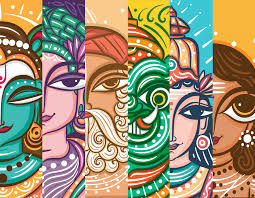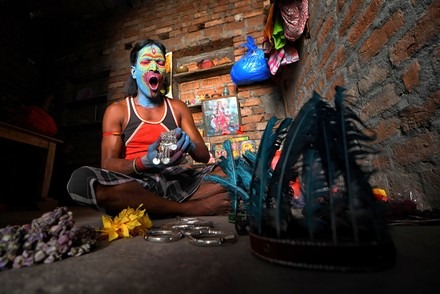
Menu

In the vibrant cultural landscape of Bardhaman, the Bahurupi community stands out as a living tradition of performance, transformation, and artistry. The term “Bahurupi” means “many forms” or “many faces,” which perfectly captures the essence of this tribal performance art rooted in Bengal’s folk heritage. Bahurupis are traditional impersonators who use elaborate face-painting, costumes, and body language to morph into gods, demons, animals, and mythological characters—captivating rural audiences with tales of faith, morality, and wonder.
The art of the Bahurupi is centered around disguise. Artists paint their faces with bright natural pigments, often using white, red, yellow, and black to create expressive masks directly on their skin. Every line and color carries symbolic meaning—white for purity, red for power, black for protection. A Bahurupi might become Lord Shiva, a fierce tiger, or a local folk deity, evoking awe through their appearance alone. Paired with handmade costumes and props, the transformation is visually striking and deeply theatrical.
In Bardhaman’s villages, Bahurupi performers appear during fairs, religious festivals, and harvest celebrations. Moving from house to house or performing in open courtyards, they entertain and bless, offering both spiritual storytelling and social commentary. Their acts, though rooted in ancient rituals, often address modern themes like poverty, justice, and environmental balance, keeping their performances relevant across generations.
Traditionally passed down through families, Bahurupi art is both a livelihood and a sacred duty. Children learn by observing elders, mastering the craft over years of informal apprenticeship. While performance is central, the painting process itself is a meditative ritual—an act of devotion as much as preparation.
Despite its cultural richness, the Bahurupi tradition has faced challenges. Urbanization, lack of institutional support, and dwindling audiences threaten its survival. Yet in Bardhaman, efforts are being made by cultural groups and folk art festivals to preserve and promote this legacy. Younger artists are adapting Bahurupi elements into street theatre, educational programs, and even social media performances.
The Bahurupi legacy is more than face-paint and mimicry—it’s a living archive of myth, performance, and identity. It connects Bardhaman’s tribal past with its artistic present, reminding us that transformation is not just an illusion, but a cultural truth beautifully expressed through color, character, and craft.

@THE INDIAN ART COTTAGE
© The Indian Art Cottage | All Rights Reserved | 2025